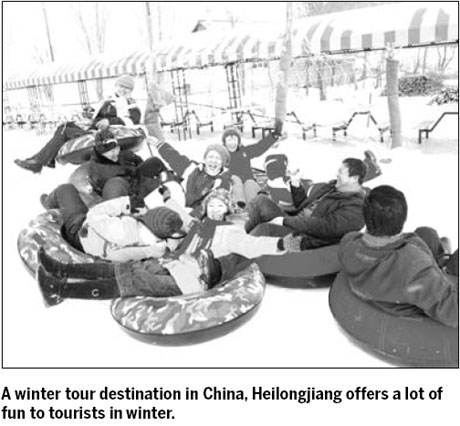Heilongjiang integrates tourism with border trade
|
Russian tourists celebrate a traditional Chinese holiday in Suifenhe. Photos provided to China Daily |
Heilongjiang, the traditional winter tour destination in China, hopes to see its tourism industry become a pillar of its economy.
According to Bo Xiru, director of the Heilongjiang Tourism Bureau, the winning card for the sector to lift its status is a strategy to integrate the tourism industry with the booming border trade.
Heilongjiang shares a 3,000 km border with Russia. In addition to offering a venue for cross-border business, the province's 25 border cities are also the entry-exit points for inbound and outbound tourists, either sightseeing or business travelers.
As more and more Russian tourists come to do business in Heilongjiang, an increasing number of Chinese tourists are trying to visit Russia via these cities.
Suifenhe, Heihe, Dongning and Fuyuan are the major cities for both border trade and tourism, with the registered number of entry-exit tourists comprising the top four in the province.
According to Bo, the province released a new tourism development plan early this year, to clearly define the orientation of Heilongjiang's tourism industry which aims to increase the province's popularity as a winter tour destination and to integrate tourism with border trade.
Leading the way
Suifenhe, the city in the eastern border of Heilongjiang is the pioneer leading this tourism-trade integration.
Russian tourists can be seen everywhere in the city. They are there for business, sightseeing, shopping and even celebrating traditional holidays like the Spring Festival.
According to Liu Jun, director of Suifenhe's tourism bureau, the number of Russian tourists in the city accounts for over 70 percent of the total in Heilongjiang.
The booming tourism is closely related with the flourishing border trade there.
Currently, over 30 percent of the city's residents are engaged in trade with Russia.
The city's major wholesale markets like Qingyun, Xushen, Jili and Juyuan are popular trading venues among Chinese and Russian traders. About 60,000 dealers from China, Russia and other countries do business there.
In addition, the city receives more than 5,000 Russian shoppers on average every day.
Liu said in Suifenhe, cross-border tourism is a natural result of border trade.
The city first opened its door for trade with the former Soviet Union in 1987.
Seeing its recognition increasing among business travelers, the city's authorities began to consider developing cross-border tours, offering an opportunity for domestic tourists to visit Russia and Russian travelers to tour China.
In February 1991, the city opened a one-day tour to Russia for domestic travelers, allowing them to visit Russian areas neighboring Suifenhe. The tentative move proved successful, so that Suifenhe government signed an agreement with the government of Vladivostok, allowing Russia's sightseeing tourists to visit Suifenhe.
In recent years, Suifenhe's tourism authority has strengthened coordination with its Russian counterparts to extend the tour routes to cover the hinterland areas of both countries.
The government of Suifenhe has also cooperated with its Russian counterparts to build highways and open a shuttle bus service to link the major scenic spots on both sides.
At present, tourism revenues account for more than 30 percent of the city's gross domestic product.

(China Daily 05/14/2010 page17)















